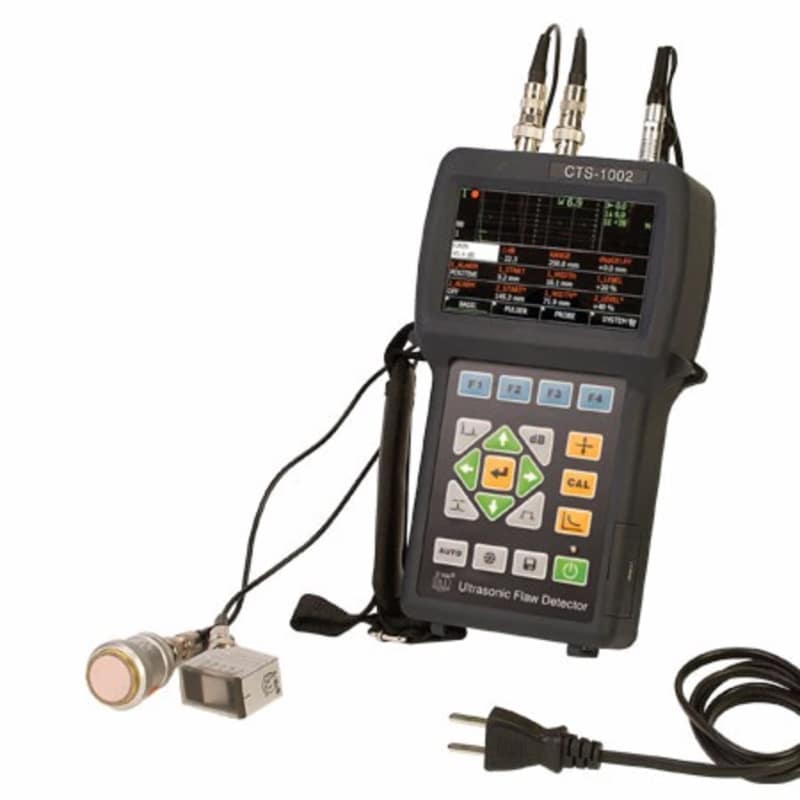There are no PDF's for this product
Of all the various uses for ultrasonics, flaw detection is the oldest and the most common. Prior to 1950, the laws of physics that govern the propagation of sound waves through solid materials have been used to detect hidden cracks, voids, porosity, and other internal discontinuities in metals, composites, plastics, and ceramics. High frequency sound waves reflect from flaws in predictable ways, producing distinctive echo patterns that can be displayed and recorded by portable instruments. Ultrasonic testing is completely nondestructive and safe, and it is a well-established test method in many basic manufacturing, process, and service industries, especially in applications involving welds and structural metals.
Ultrasonic flaw detection is basically a comparative technique. Using appropriate reference standards along with a knowledge of sound wave propagation and generally accepted test procedures, a trained operator identifies specific echo patterns corresponding to the echo response from good parts and from representative flaws. The echo pattern from a test piece may then be compared to the patterns from these calibration standards to determine its condition.
The HFD-1 is a digital ultrasonic flaw (inclusion) detector with 800 x 480 WVGA display for superior visibility in all lighting conditions, including direct sunlight. Using the advanced tunable squarewave excitation technology, the HFD-1 provides excellent material penetration and a high signal to noise ratio when detecting special composite materials, highly attenuated or thick work pieces. The zoom function for the in-gate waveform allows users to observe the waveform detail conveniently with an optimized height to width rate to insure a higher resolution. The HFD-1 has different color change of the waveform for visual and an optional alarm function. The auto calibration includes fast calibrating material velocity, probes time delay and angle of signal. The USB port allows access for updating the software, downloading and printing of the data.
Specifications
Accuracy: ≤ 3% vertical linearity
Operating Frequency: Broadband 0.5 to 20 MHz, optional narrowband 1.5 to 3 MHz
Pulse Width: 50 to 800 ns with 5 ns increments
Resolution: ≥ 36 dB
Suppression: 0 to 90%
Enclosure: NEMA 3 (IP54)
Temperature Range: -30 to 50°C (-22 to 122°F)
Humidity: 20 to 90% RH
Communications: USB port
Power: Lithium battery (included)
Weight: 0.9 kg (2 lbs)
Dimensions: 215 L x 126 W x 53 mm H (8.5 x 5 x 2″)
Of all the various uses for ultrasonics, flaw detection is the oldest and the most common. Prior to 1950, the laws of physics that govern the propagation of sound waves through solid materials have been used to detect hidden cracks, voids, porosity, and other internal discontinuities in metals, composites, plastics, and ceramics. High frequency sound waves reflect from flaws in predictable ways, producing distinctive echo patterns that can be displayed and recorded by portable instruments. Ultrasonic testing is completely nondestructive and safe, and it is a well-established test method in many basic manufacturing, process, and service industries, especially in applications involving welds and structural metals.
Ultrasonic flaw detection is basically a comparative technique. Using appropriate reference standards along with a knowledge of sound wave propagation and generally accepted test procedures, a trained operator identifies specific echo patterns corresponding to the echo response from good parts and from representative flaws. The echo pattern from a test piece may then be compared to the patterns from these calibration standards to determine its condition.
The HFD-1 is a digital ultrasonic flaw (inclusion) detector with 800 x 480 WVGA display for superior visibility in all lighting conditions, including direct sunlight. Using the advanced tunable squarewave excitation technology, the HFD-1 provides excellent material penetration and a high signal to noise ratio when detecting special composite materials, highly attenuated or thick work pieces. The zoom function for the in-gate waveform allows users to observe the waveform detail conveniently with an optimized height to width rate to insure a higher resolution. The HFD-1 has different color change of the waveform for visual and an optional alarm function. The auto calibration includes fast calibrating material velocity, probes time delay and angle of signal. The USB port allows access for updating the software, downloading and printing of the data.
Specifications
Accuracy: ≤ 3% vertical linearity
Operating Frequency: Broadband 0.5 to 20 MHz, optional narrowband 1.5 to 3 MHz
Pulse Width: 50 to 800 ns with 5 ns increments
Resolution: ≥ 36 dB
Suppression: 0 to 90%
Enclosure: NEMA 3 (IP54)
Temperature Range: -30 to 50°C (-22 to 122°F)
Humidity: 20 to 90% RH
Communications: USB port
Power: Lithium battery (included)
Weight: 0.9 kg (2 lbs)
Dimensions: 215 L x 126 W x 53 mm H (8.5 x 5 x 2″)
 Would you like to know more?
Would you like to know more?
Our team can help you with any product information, quotes, or any general questions you may have about the product.

Putting the ‘direct’ in directory since 2009. With our global catalogue of quality safety and environmental monitoring products all under one roof, we put an end to lengthy, saturated searches. At OSE, just find and enquire and we will put you in touch with the right person to make your product purchase.


"*" indicates required fields
